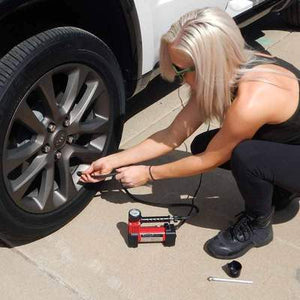Free Shipping Every Day
Free Shipping Every Day

by john moser February 27, 2019
Tires are probably the most important parts of a safe vehicle. This is mainly because the tires are the only part of your car that touches the roadway. Tires directly impact your car handling, braking, ride, and most importantly safety.
For the best performance, tires should have the right tread depth, air pressure, and balance. Also, the wheels of your vehicle should be properly aligned. Young drivers tend to overlook the importance of fire safety. To keep you safe on the road, always be prepared with a Superflow portable air pump. Here are the top 5 tire safety tips you need to follow:
1. Buy the Best Tire for the Job
Many drivers purchase a tire mainly depending on their initial price and appearance, which is not the right way to go. The selection of tires must be based on the best size that is recommended for a specific vehicle as well as its load recommendations.
A majority of vehicles come with good all-season tires, these tires are the equivalent of a jack-of-all-trades. The decision also depends on the weather. So, for example, if you reside in the rust belt, it is better to go for a pair of dedicated and high-quality snow tires for the winter. This is because they are great in terms of safety. On the other hand, if you live somewhere warm and dry, then "summer" performance tires are likely to considerably enhance your vehicle's handling.
You can also consult an experienced and knowledgeable automobile or tire dealer about choosing the most suitable tire for your specific driving habits and patterns.
2. Tire Pressure
It is advisable to keep tire pressure at the recommended level to ensure the safety of your car’s occupants. It is worth emphasizing that low tire pressure is likely to cause your tires to lose the grip on rainy and wet surfaces, which can be very dangerous. To determine the amount of pressure your tires need, for stock tires, look up the number in the vehicle owner's manual or on the car door. If using aftermarket tires, consult with the car manufacturer.
Tires have the tendency to lose air with time. This loss is about one PSI a month and about one PSI for each 10-degree drop in temperature.
Keep in mind that under-inflation is a tire’s worst enemy, as it could cause serious damage, which can lead to tire failure. On the other hand, over-inflation may cause uneven wear as well as stopping and handling problems. This reason is why you should purchase a digital tire gauge to carefully check the tires once each month and prior to a long trip.
To be sure you're always driving with properly inflated tires, check your pressure frequently and always have an air pump for car tires like superflowair tire inflator on hand.
3. Do Not Forget the Spare Tire
One of the worst experiences is getting a flat tire only to discover that the spare is flat as well. Therefore, inspect the spare tire just like you would inspect your other tires. Having a spare will give you peace of mind. The inflation pressure will often be mentioned on the tire in case you have a compact spare. In case your vehicle comes with a flat repair kit or compressor instead of a spare, check their operation on a regular basis.
Also, 12 V tire inflators provide a fast and convenient solution for drivers who have a flat tire. You can re-inflate it using a pressurized gas and provide enough pressure to allow the car to be driven well at a desirable speed.
4. Check for Tread Depth
You should check your tire tread depth at least once per month. There are two important reasons for this. Proper tread depth can help prevent hydroplaning; it is a phenomenon where your vehicle slides on a thin sheet of water. Secondly, it helps your tires maintain traction while improving handling.
There are many popular ways for checking your tire tread depth. One simple way is known as the penny test. All you have to do is pop in a penny into the tire's tread groove and keep Lincoln's head on the penny upside down. If all of Lincoln's head is visible to you, the tread depth is less than 2/32 inch and it is time to change the tires.
5. Check for Wear and Damage
When you are checking for tread depth, make sure you check both the outside and inside edge of your tires. Also, check the tire sidewalls to spot cuts, gouges, bulges, cracks or other irregularities. This damage is usually hard to repair and will need replacement of your tire.
Also, it is worth mentioning that uneven tire wear is often an indication that your vehicle is out of alignment. Remember that proper alignment helps optimize handling while preventing premature tire wear.
Always inspect your car tires before embarking on a long trip. The more often you perform these inspections, the easier it would be to identify small problems, like a nail in the tire, and fix them before they escalate into bigger issues.
by John Moser September 25, 2019
by John Moser September 25, 2019
by John Moser September 25, 2019
john moser
Author